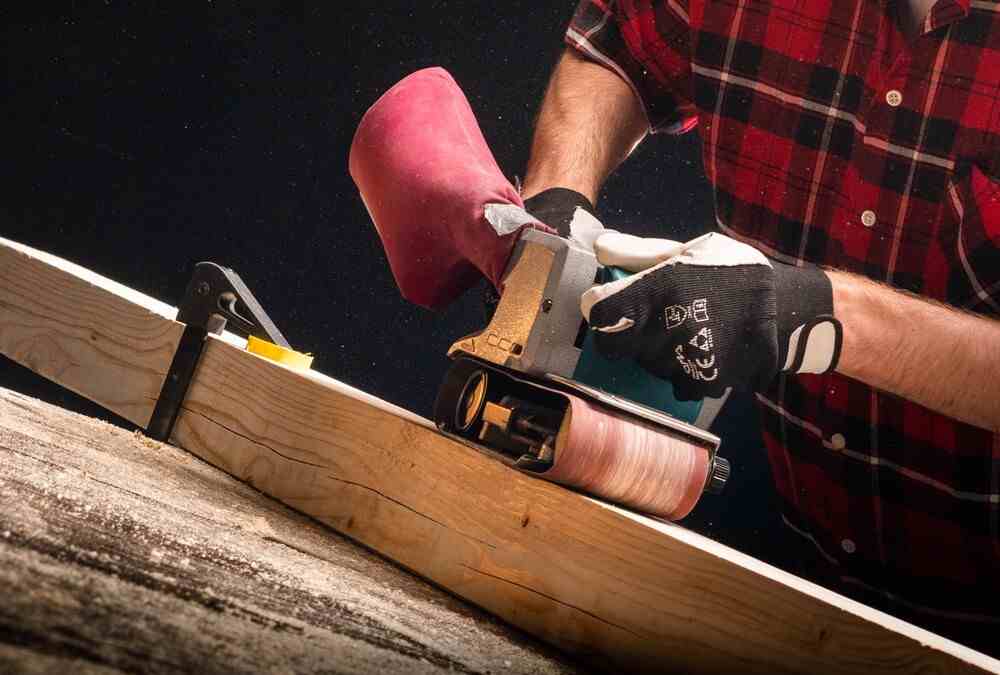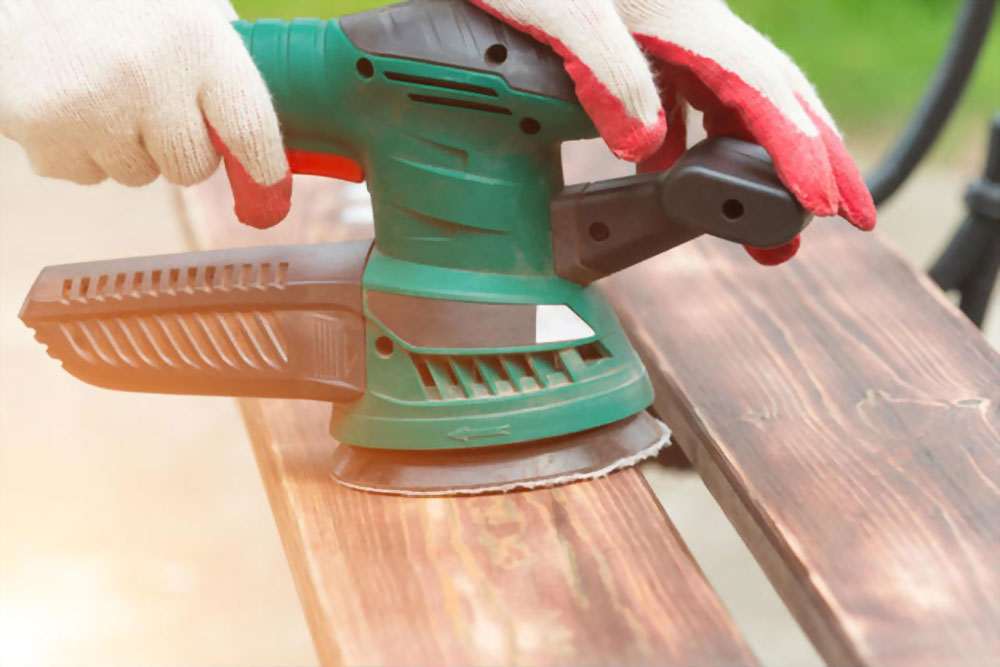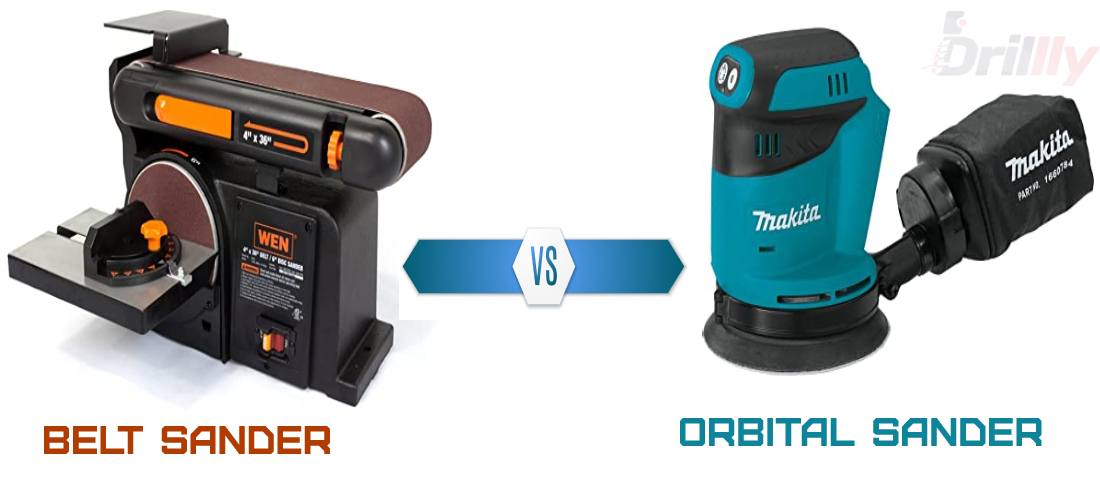Innovation has changed the way homeowners that are DIY enthusiasts use home improvement tools. Usually, the garage holds a collection of old and valuable items. While remodeling their homes, these DIY enthusiasts carry out remediation tasks to restore the integrity of old items that might be useful. Both the belt sander and orbital sander are DIY tools for removing rust, and detailing wood. They are handy, user-friendly and valuable power tools that make life easy for every DIYer.
When it comes to orbital sander vs belt sander, it’s not everyone that knows the difference between them. Even when they both meet the specifications for sanding tasks; the belt sander is for heavy-duty tasks, and the orbital sander isn’t designed to remove heavy stock. So, they both might be sanding tools, but are different devices that use sandpapers in unique ways. Let’s unveil other striking features that come with these handheld, sanding tools.
What is a Belt Sander?

The Belt Sander uses variable speed to create a smooth finish on large, flat surfaces that are very rough. It’s the belt sander’s brute strength that makes it suitable for aggressive work and the removal of a lot of material from large surfaces. After my experience with different models of belt sanders, I am thrilled by the versatility and ease of controlling this type of power tool when it runs at a low speed.
However, novice operators must be careful when using belt sanders because when they apply excessive pressure, the grains might clog up the sander’s abrasive belt. This condition will reduce the sanding tool’s efficiency, and durability.
Generally, models of belt sanders are available in four standard sizes that include 3×18 inch, 4×24 inch, 3×21 inch, and 3×24 inch. You’ll often see the 3×21-inch model because it has a right blend of speed, stability, and power. The largest belt sander is the 4×24 inch model that’s built for heavy-duty sanding, and it’s popular because it’s aggressive sander can damage large, flat surfaces when used with inexperience. However, the 3×24-inch belt sander covers larger surfaces than the 3×21-inch model, but it has less balance and ease of control.
I’ll recommend the 3×18-inch belt sander for a novice operator because this model is compact and very easy to control. Typically, belt sanders can handle a range of leveling task that includes stripping off old finish (paint o stains), rust particles from metals, and rough surfaces of wood. Start your sanding task with a 60-grit belt and move to (intermediary steps) finer grits when you want impressive smoothness levels with belt sanders.
What is an Orbital Sander?

An Orbital Sander is a hand-held sanding tool that uses a square pad of sandpaper for finishing works. Unlike the belt sander that removes loads of grains, the orbital sander’s sanding pad isn’t meant for removing heavy stock when it moves in a circular pattern. Instead, it brings finesse and leaves a smooth surface after finishing the job of a belt sander. The style of sanding off metal and wood surfaces in a circular direction makes orbital sanders ideal finishing tools.
An orbital sander uses one-quarter of 9×11-inch sandpaper to help you optimize the surface finish of a material. Usually, artisans and craftspeople refer to orbital sanders as quarter-sheet sanders. This name describes the size of sandpaper that fits the orbital sander.
Also, the orbital sander’s disc has two spring-enabled clamps for attaching the sandpaper onto its flat pad. As the pad vibrates, it makes orbital movements in randomly. Let’s clarify that orbital sanders have different designs from random-orbit sanders (orbital finishing sander), but they are both handheld tools with compact housings. The little difference is that random-orbit sanders have round sanding pads, and orbital sanders have flat, square sanding pads. You’ll notice that both random-orbit and orbital sanders have slow times of operations.
Belt Sander Vs Orbital Sander – Comparative Analysis

Before getting any further, you must understand that both tools are types of electric power sanders. They are important tools for sanding the surfaces and reducing the level of roughness of metal and wood. Except for rust, and paint removal, orbital sanders can level grain stock, and mill marks from the surface of wooden materials. However, both sanding tools perform similar general functions, but in varying degrees. Let’s see what makes belt sanders, orbital sanders, and random-orbit sanders different.
While the sanding pads of orbital sanders are flat and square, the belt sander uses an attachment of an abrasive material (belt) that forms a continuous loop. The reinforced abrasive material (sandpaper) is tensioned on two cylindrical drums. While the rear drum and sandpaper belt are propelled by a built-in motor, the front drum ensures a free spin that moves the tool in a single direction.
The orbital sander’s pad makes random movements in small circles, but the belt sander moves in linear motion. Usually, the belt sander comes with a knob that adjusts the speed settings. Regardless of its variable speed setting, the belt sander moves with more speed than an orbital sander.
It’s the design of a belt sander that allows it to grind paint or rust off the surface of materials. However, the orbit sander’s design ensures the shaping and finishing of wood before they are polished. So, it will be a waste of energy, and risk of damaging the sandpaper when you attempt to remove coats and stains with an orbital sander. Except for prepping, the belt sander tool can’t optimize the surface finish like orbital sanders.
Changing the sandpaper belt in a belt sander is easy. Simply adjust the tension-release lever, and detach the old belt from the drums. Then insert a new attachment belt to both drums and tighten the lever. However, both orbital sanders and random-orbit sanders use cut-to-size sandpapers. It means you’ll have to cut the sandpapers to fit the sizes of their square and round sanding pads respectively. They have adjustable clamps that act as levers for holding these sandpapers firmly.
Another difference is their motion. The vibrating pads of orbital sanders and random-orbit sanders move in random motions and at slow rates. This random motion ensures they offer ultra-smooth sanding for sharp edges of the wood and sanding off the crusts of hardened putty. However, the grit of belt sanders move at a higher speed than orbital sanders, but the speed is adjustable.
Conclusion
Most times novice DIYers and craftsmen are unable to distinguish between a belt sander and an orbital sander. They are more confounded when they see random-orbit sanders in local stores. Understanding what aligns with your purpose can save the embarrassment of performing shoddy jobs with the wrong tools. However, we have explained the nitty-gritty of each sanding tool and shared our experiences with these sanders.
Generally, the orbital finishing sander, random-orbit sander, and belt sander are electric sanding tools that perform different functions. It’s important to use the right abrasive (sandpaper) when you plan to use any of these three sanding tools. Use protective gear like the dual-cartridge respirator when sanding off paints or grains of wood. Additionally, you should attach a dust-collection bag to the vacuum when using electric sanders. This set up ensures the prevention of grains from contaminating your respiratory tract.







